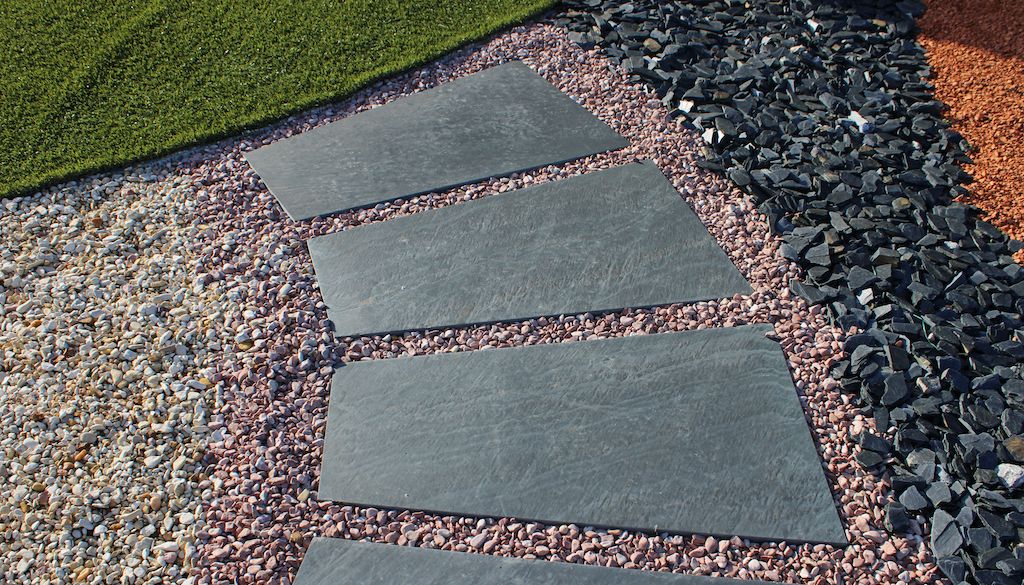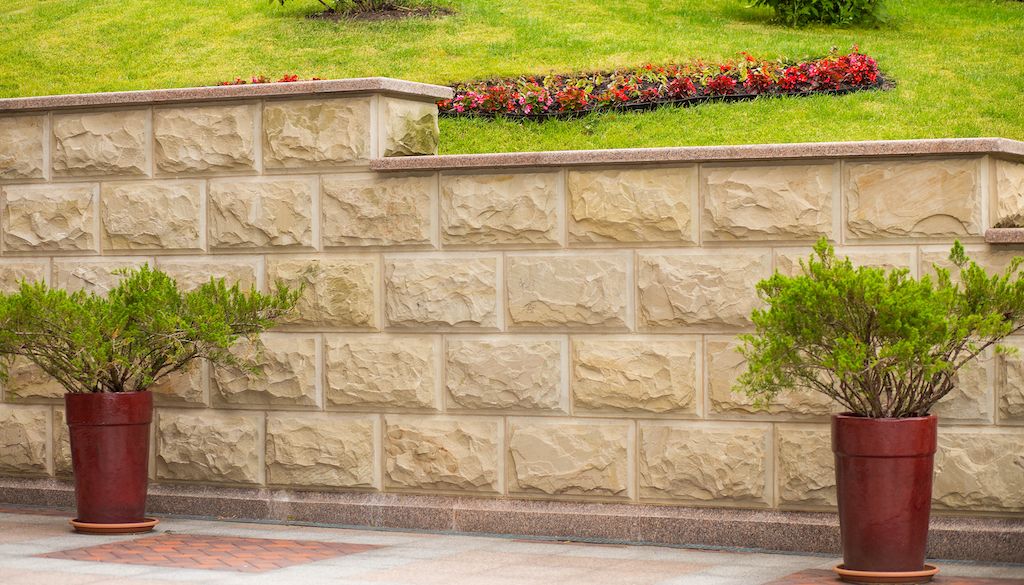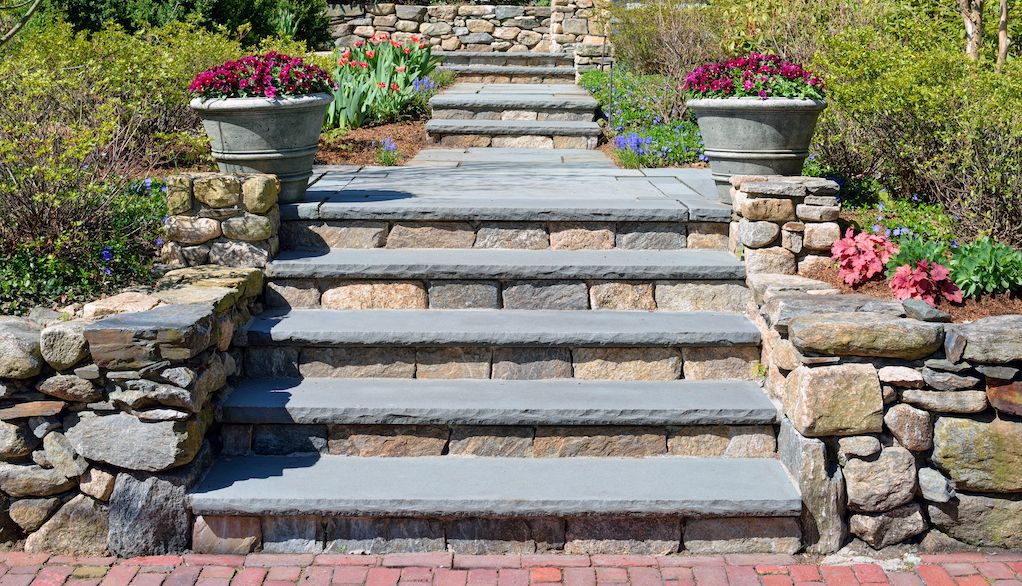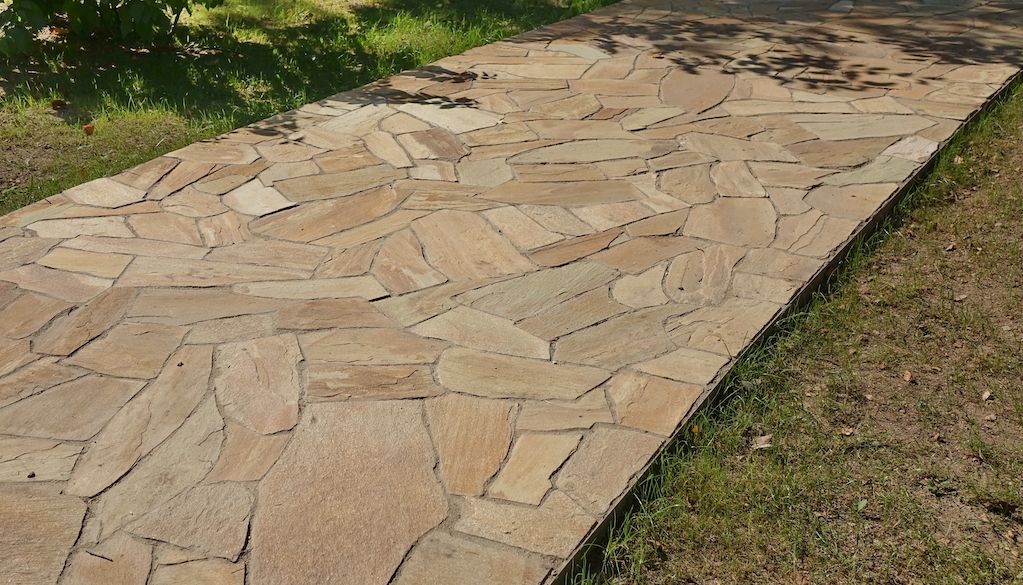What is flagstone made of?
Flagstone is a sedimentary stone that consists of metamorphic and igneous rock and comprises pieces of rock that naturally break along the stones' lines or planes.
What does flagstone look like?
Flagstone comes in all shapes and sizes, and some of the most common colors include brown, peach or pink, red, gray, khaki, cream, gold, beige, blue, green and more.
You can find stones that are jagged or irregularly shaped, which is great if you want to create a more natural, rugged aesthetic. Or, choose stones that are rectangular, square or round for a cleaner, neater appearance. You can also cut paver stones to create curves and straight edges.
Types of flagstone.
There are several types of stones that are considered to be flagstone. Here's a rundown of some of the most common varieties:
Slate.
 Slate has a timeless look. It's used in roofing, but you can also consider it for paver patios, walkways and even indoor flooring. Colors range from green and gray to red, black, brown and purple.
Slate has a timeless look. It's used in roofing, but you can also consider it for paver patios, walkways and even indoor flooring. Colors range from green and gray to red, black, brown and purple.
Sandstone.
 This type of stone has a rustic aesthetic. You can use it to create stepping stones, edging, retaining walls and patios. If you love earthy finishes, this type of stone is for you.
This type of stone has a rustic aesthetic. You can use it to create stepping stones, edging, retaining walls and patios. If you love earthy finishes, this type of stone is for you.
Bluestone.
 Bluestone is a dense and durable stone. It's a type of sandstone (or limestone, depending on the rock) with a distinct bumpy texture. Bluestone is available in dark hues like gray or blue, and lends a lovely aged look to walkways, steps, pool decks and patios.
Bluestone is a dense and durable stone. It's a type of sandstone (or limestone, depending on the rock) with a distinct bumpy texture. Bluestone is available in dark hues like gray or blue, and lends a lovely aged look to walkways, steps, pool decks and patios.
Limestone.
 Shell fragments are often visible in this sedimentary rock. Limestone usually comes in white or gray, although you may also find it in yellow or beige. Consider it for pathways or retaining walls. You can also use crushed gravel to create a walkway, landscape edging and even a French drain.
Shell fragments are often visible in this sedimentary rock. Limestone usually comes in white or gray, although you may also find it in yellow or beige. Consider it for pathways or retaining walls. You can also use crushed gravel to create a walkway, landscape edging and even a French drain.
Basalt.
 This type of rock is ideal for neutral-shaded patios, as it comes in dark gray and black and has a heavily textured porous aesthetic. You can find boulders made out of basalt to use in your landscaping. It's also used in water features, retaining walls and more.
This type of rock is ideal for neutral-shaded patios, as it comes in dark gray and black and has a heavily textured porous aesthetic. You can find boulders made out of basalt to use in your landscaping. It's also used in water features, retaining walls and more.
How long does flagstone last?
Flagstone is exceptionally durable and has a minimum lifespan of 50 years. However, that depends on whether you take good care of it and protect it from harsh elements.
Where to use flagstone in your landscaping.
You can use this natural stone in a variety of outdoor areas, including:
- Walkways and pathways
- Patios
- Swimming pool decks
- Water features
- Garden and lawn edging
- Retaining walls
- Outdoor fireplaces
- And more
Flagstone cost considerations.
The price per square foot of the space you want to pave primarily determines how much it will cost to use this type of stone in your landscaping project. The specific kind you use (slate, limestone, bluestone, etc.) and local labor rates are all major considerations as well.
For an accurate cost estimate, contact local landscapers and ask for price quotes.
Flagstone pros and cons.
Like most base materials, flagstone has advantages and disadvantages for various applications. Weigh these to help you make a more informed decision:
Pros | Cons |
Resilient and durable | Can be costly, depending on several factors |
Comes in array of shades, colors, sizes, and shapes | Installation can be labor intensive |
Versatile; can be used in landscaping and inside the home | Susceptible to chipping or fading over time or due to the weather |
Start a landscaping project on Thumbtack today.
Installing flagstone doesn't have to be tedious. Download the Thumbtack app today, and hire a landscaper. Get free cost estimates, and let a professional help you decide which type of stone to use for your project.
FAQs
What is the difference between slate and flagstone?
Slate is a type of flagstone. Slate is a fine, uniform sedimentary rock made of clay or volcanic ash that has changed into thin layers. Flagstone is a term used to describe various natural stones, such as slate, bluestone, limestone and sandstone.
What's the difference between bluestone and flagstone?
Bluestone is another type of flagstone. It's a sedimentary rock and a popular choice for uneven stones and dimensional pavers.
Flagstone is a term used to categorize different types of stones, including bluestone, sandstone, limestone, slate and more.